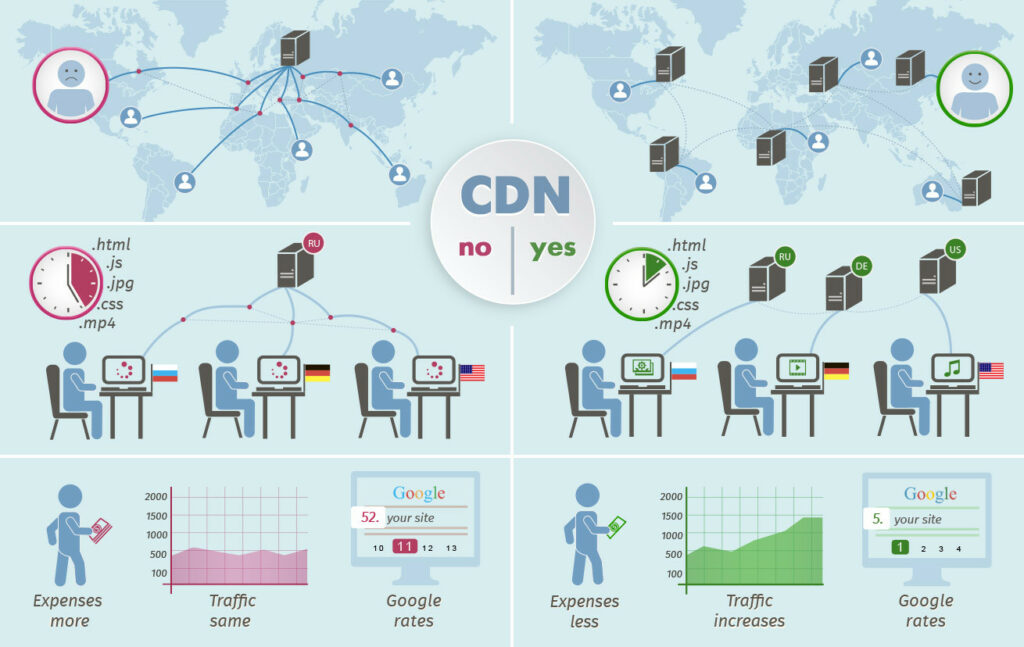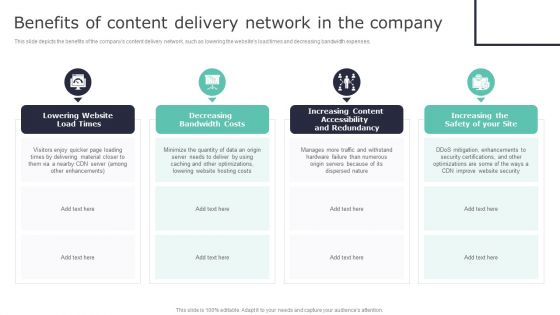Unravel the mystery behind content delivery networks and discover how they optimize website performance and improve user experience.

Image courtesy of via DALL-E 3
Table of Contents
Introduction to Content Delivery Network (CDN)
Have you ever wondered how the internet works and how we are able to access websites and videos so quickly? Well, one of the key players that make this possible is a content delivery network (CDN). Let’s dive into what CDNs are and why they are important for our online experience!
What is a CDN?
Simply put, a content delivery network or CDN is like a super-fast delivery service for the internet. It’s a system of servers spread out all over the world that work together to make sure websites and other online content reach you quickly and efficiently.
Why do we need CDNs?
Imagine you want to watch a video on YouTube or visit your favorite website. Without CDNs, these websites would take much longer to load because they would have to send data all the way from their main server to your device. CDNs help by storing copies of this data on servers closer to you, so you can access it faster!
How Does a CDN Work?
Content Delivery Networks, or CDNs, work by utilizing a network of servers strategically located around the world to deliver content to users in a fast and efficient manner. Let’s break down the technical aspects of how CDNs function in a simple way.
Servers Around the World
Imagine CDNs as a team of servers working together to make sure internet content reaches you quickly. These servers are spread out in different places globally, like messengers stationed all over the world ready to bring you the information you need.
Data Delivery
When you click on a website, like your favorite cat videos page, the CDN helps fetch those videos from the nearest server to you. This means the videos don’t have to travel far, making it faster for you to enjoy them. It’s like having a personal delivery service for internet content!
Benefits of Using a CDN
One of the main benefits of using a Content Delivery Network (CDN) is faster loading times for websites. CDNs work by storing copies of a website’s content on servers around the world. This means that when you visit a website, the content can be delivered from a server closer to you geographically, reducing the time it takes for the website to load on your screen.

Image courtesy of excitingip.com via Google Images
Better Performance
CDNs also help in enhancing the overall performance of websites. By distributing content across multiple servers, CDNs can handle high volumes of traffic more efficiently. This helps prevent websites from crashing during peak times and ensures a smoother browsing experience for users.
Increased Security
Another important benefit of CDNs is increased security. CDNs can provide protection against cyber attacks such as Distributed Denial of Service (DDoS) attacks by filtering malicious traffic before it reaches the website’s server. This helps in keeping both the website and its users safe from potential threats.
Real-Life Examples of CDNs
Many popular websites rely on content delivery networks (CDNs) to ensure fast loading times and smooth user experiences. Websites like Amazon, Netflix, and YouTube use CDNs to deliver their content quickly and efficiently to users all around the world. By storing copies of their content on servers located in different regions, these websites can reduce latency and provide a seamless browsing experience for their users.
Streaming Services and CDNs
Streaming services like Spotify and Hulu also utilize CDNs to deliver high-quality video and audio content to their subscribers. By caching popular content on servers closer to users, these services can reduce buffering times and provide a smooth streaming experience. CDNs play a crucial role in delivering uninterrupted entertainment to millions of users worldwide.
How CDNs Keep Us Connected
Have you ever wondered how websites load so quickly when you click on them? Well, CDNs play a big part in making that happen! When you are trying to access a website, the content you see – like images, videos, and text – is stored on servers located all around the world. CDNs help deliver this content to your device from the server that is closest to you. This quick and efficient delivery process ensures that you can browse the internet seamlessly without any delays.

Image courtesy of cyberhoot.com via Google Images
Playing Online Games
For all the gamers out there, CDNs also play a crucial role in making online gaming experiences smooth and enjoyable. When you play online games with your friends or against other players from different parts of the world, CDNs help in reducing the lag or delay in your game. By storing game data on servers worldwide and delivering it quickly to your device, CDNs ensure that you can play your favorite games without interruptions or glitches. So, the next time you’re dominating the leaderboards in your favorite online game, remember to thank CDNs for keeping you connected!
Challenges CDNs Face
One of the common challenges that Content Delivery Networks (CDNs) face is network congestion. Imagine a highway with too many cars trying to get through at the same time. When there is too much data traveling on the network, it can slow down the delivery of content to users. CDNs have to find ways to manage this congestion to ensure that websites load quickly and smoothly for everyone.
Technical Issues
In addition to network congestion, CDNs also encounter technical issues from time to time. Just like how your computer or phone can sometimes have glitches or errors, CDNs can face similar problems. These technical difficulties could be anything from a server malfunction to a software bug. It’s crucial for CDNs to quickly identify and fix these issues to maintain a seamless internet experience for users.
Future of CDNs
As technology continues to advance at a rapid pace, the future of Content Delivery Networks (CDNs) holds exciting possibilities. Let’s take a look at how CDNs might evolve and improve in the coming years.

Image courtesy of www.slidegeeks.com via Google Images
Emerging Technologies
One of the key areas where CDNs are expected to see significant advancements is in the integration of emerging technologies. Innovations such as edge computing, machine learning, and artificial intelligence are likely to play a crucial role in shaping the future of CDNs.
Enhanced Capabilities
Future CDNs may offer enhanced capabilities that go beyond just accelerating content delivery. Imagine a CDN that can not only cache and deliver content quickly but also automatically optimize that content based on user preferences and behavior. This personalized approach could revolutionize the way we experience the internet.
Undefined
As technology continues to advance, content delivery networks (CDNs) are also evolving. New innovations are shaping the future of how CDNs operate and deliver content to users.
Enhanced User Experience
One potential area of improvement for CDNs is enhancing the overall user experience. Future CDNs may focus on providing even faster loading times and smoother data delivery, making the internet experience seamless for users.
Integration with Emerging Tech
CDNs are likely to integrate with emerging technologies such as artificial intelligence and machine learning. These advancements could optimize content delivery, customize user experiences, and improve overall performance.
Global Connectivity
Future CDNs may further enhance global connectivity by expanding their server networks to more regions around the world. This could lead to even faster data delivery and improved access to online content for users worldwide.
Want to turn these SEO insights into real results? Seorocket is an all-in-one AI SEO solution that uses the power of AI to analyze your competition and craft high-ranking content.
Seorocket offers a suite of powerful tools, including a Keyword Researcher to find the most profitable keywords, an AI Writer to generate unique and Google-friendly content, and an Automatic Publisher to schedule and publish your content directly to your website. Plus, you’ll get real-time performance tracking so you can see exactly what’s working and make adjustments as needed.
Stop just reading about SEO – take action with Seorocket and skyrocket your search rankings today. Sign up for a free trial and see the difference Seorocket can make for your website!
undefined
Emerging Technologies
As technology continues to advance at a rapid pace, the future of Content Delivery Networks (CDNs) looks very promising. One exciting area to keep an eye on is the development of emerging technologies that could revolutionize how CDNs operate.
For example, the rise of edge computing is likely to have a significant impact on CDNs. Edge computing involves processing data closer to the source, which can lead to faster response times and improved efficiency. CDNs may leverage edge computing to enhance their delivery speeds and overall performance.
Additionally, the integration of artificial intelligence (AI) and machine learning into CDNs could streamline content delivery processes. AI algorithms can analyze data patterns and user behaviors to optimize delivery routes and ensure faster loading times. This could result in a more personalized and efficient user experience.
Enhanced Capabilities
Looking ahead, future CDNs may boast a range of enhanced capabilities that go beyond traditional content delivery. One exciting possibility is the integration of virtual reality (VR) and augmented reality (AR) technologies into CDNs.
Imagine being able to seamlessly stream high-definition VR content without any lag or buffering. Future CDNs could leverage VR and AR capabilities to deliver immersive experiences to users around the world, transforming how we consume and interact with digital content.
Moreover, advancements in secure socket layer (SSL) encryption and blockchain technology could enhance the security features of CDNs. By implementing robust encryption protocols and decentralized security mechanisms, future CDNs may offer unparalleled levels of data protection and privacy for users.







